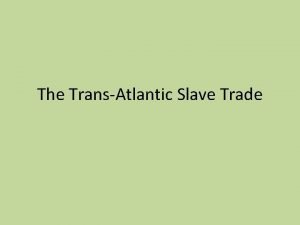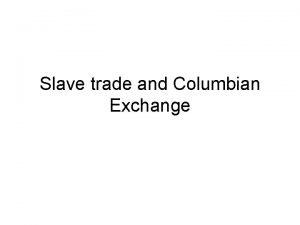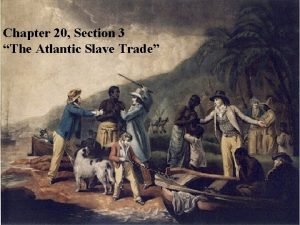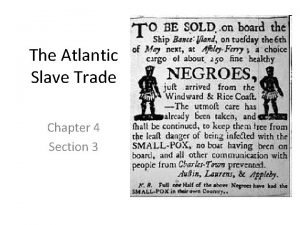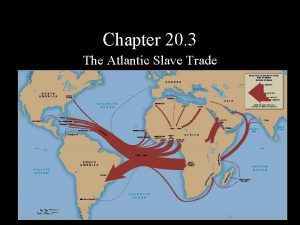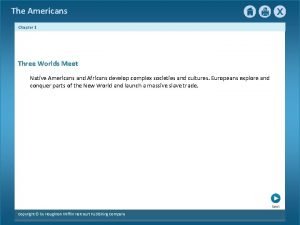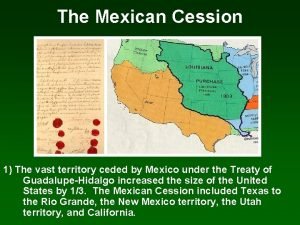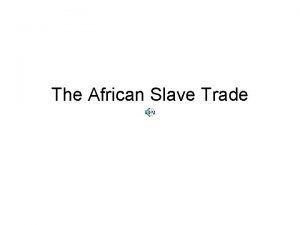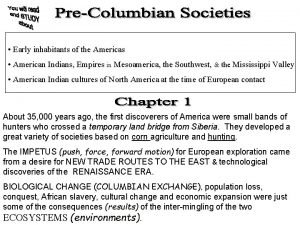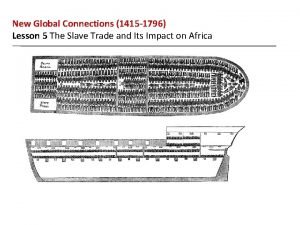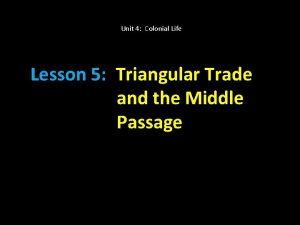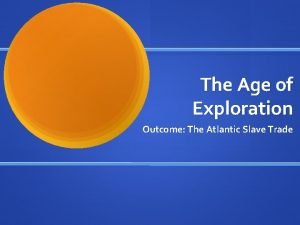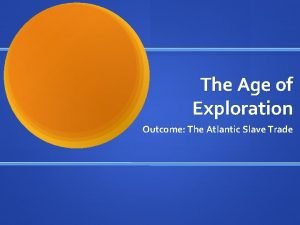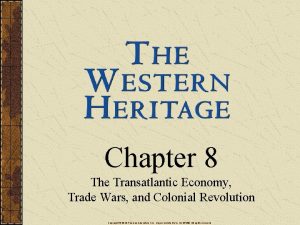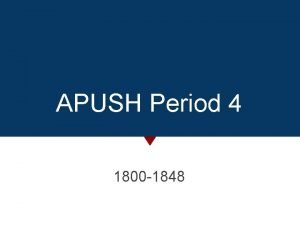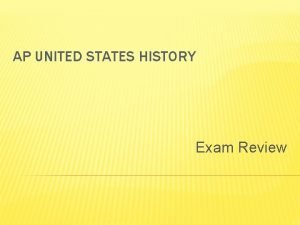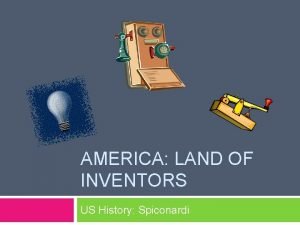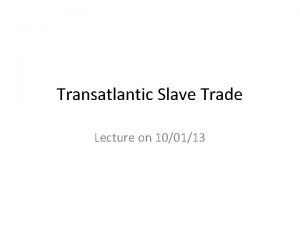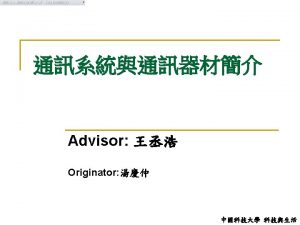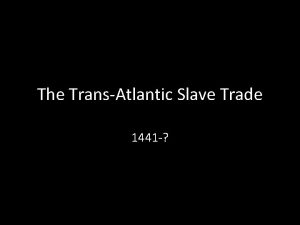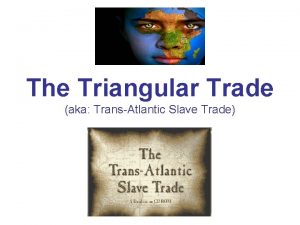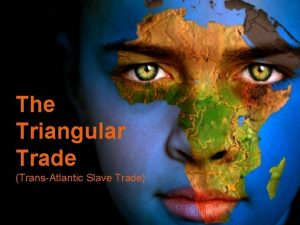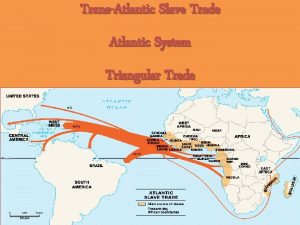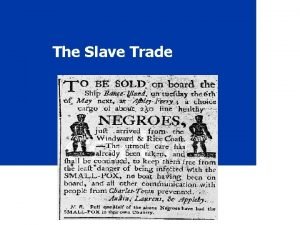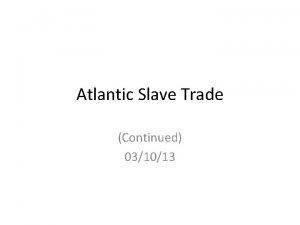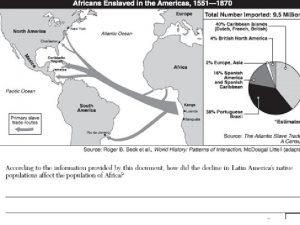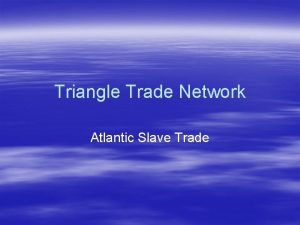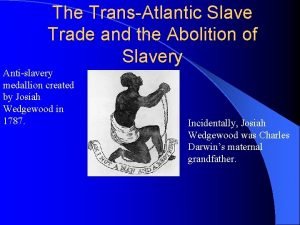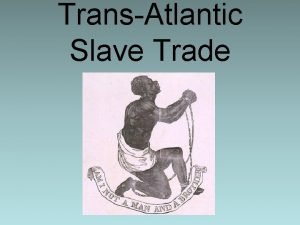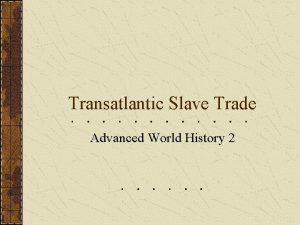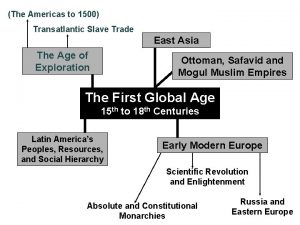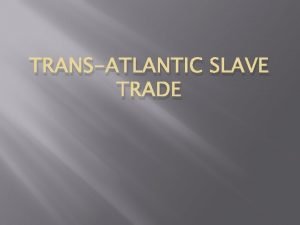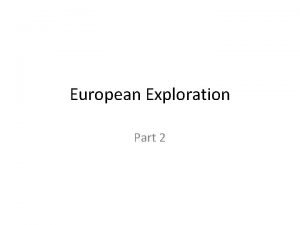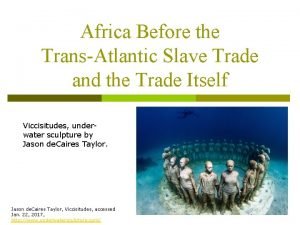The transAtlantic Slave Trade Chapter 13 Section 2























- Slides: 23

The trans-Atlantic Slave Trade Chapter 13 Section 2. 3

The Main Idea The European slave trade involved millions of people and had lasting effects on Africa and the Americas

Terms and Names Trans-Atlantic slave trade Triangular trade Middle Passage Olaudah Equiano (O-la-ow-dah)

Slavery Existed in Africa before the Europeans came Enslaved war captives Muslim slave trade

European Slave Trade Portuguese were first – 1400 s Trans-Atlantic slave trade- trading slaves across the Atlantic ocean Started in 1500

Why slavery? Plantations (large farms) needed labor for growing demand Demand for goods = Bigger Plantations = Demand for labor= African slavery $$$$$$$$$$$$$$$$$ What were the benefits to the plantation owner of buying a slave instead of hiring a worker?


Trans-Atlantic Slave Trade Enslaved people were kidnapped or taken in war Forced to the coasts of Western Africa Help captive there until they were sold Spanish, Dutch, French, English purchased slaves

Trans-Atlantic Slave Trade After purchased, slaves were put on ships headed to the Americas. The trip across the Atlantic was known as the Middle Passage Could take several months





Provisions for the Middle Passage Slaves fed twice per day Poor and insufficient diet • • • Vegetable pulps, stews, and fruits Denied meat or fish Ten people eating from one bucket Unwashed hands spread disease Malnutrition ~ weakness ~ depression ~ death

Forced Journey Many Africans jumped overboard to their deaths rather than be enslaved. Diseases ravaged the “passengers” Cruel treatment ravaged more


Forced Journey The voyage across the Atlantic was dehumanizing, and deadly Nearly 1/3 died between capture and sailing Another 1/3 died in the crossing

Why Africans? There were several advantages in using Africans: They had been exposed to European diseases They had experience in farming They had little knowledge of the land there were no familiar tribes


Resistance and Revolt at Sea Uprisings were common Most rebellions before sailing Some preferred death to bondage Justification for harsh treatment by slavers


Conclusion Nine to eleven million Africans brought to the Americas during three centuries of trade Millions more died Most arrived between 1701 and 1810 Only 600, 000 reached the British colonies of north America

Consequences of the Atlantic Slave Trade In Africa, numerous cultures lost generations of their strongest members, both men and women. The slave trade introduced guns to the African continent African slaves contributed greatly to the cultural and economic development of the Americas. Africans brought their culture to the Americas
 Triangular trade video
Triangular trade video Transatlantic slave trade pictures
Transatlantic slave trade pictures Triangular trade apush
Triangular trade apush The transatlantic slave trade
The transatlantic slave trade The transatlantic question
The transatlantic question Chapter 20 section 3 the atlantic slave trade
Chapter 20 section 3 the atlantic slave trade Chapter 4 section 3 the atlantic slave trade
Chapter 4 section 3 the atlantic slave trade The atlantic slave trade chapter 20 section 3
The atlantic slave trade chapter 20 section 3 Chapter 1 three worlds meet
Chapter 1 three worlds meet Washington dc slave trade
Washington dc slave trade Atlantic slave trade
Atlantic slave trade Effects of the slave trade on africa
Effects of the slave trade on africa Lesson 5 the slave trade and its impact on africa
Lesson 5 the slave trade and its impact on africa Slave trade primary sources
Slave trade primary sources Destination america
Destination america The age of exploration outcome the atlantic slave trade
The age of exploration outcome the atlantic slave trade The age of exploration outcome the atlantic slave trade
The age of exploration outcome the atlantic slave trade Transatlantic tunnel
Transatlantic tunnel Gustavus swift inventions
Gustavus swift inventions Transatlantic slaves
Transatlantic slaves 1800 apush significance
1800 apush significance Transatlantic encounters in history of education download
Transatlantic encounters in history of education download Transatlantic telegraph cable apush
Transatlantic telegraph cable apush Trade diversion and trade creation
Trade diversion and trade creation

